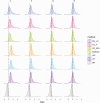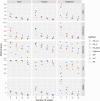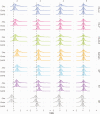A Comparative Analysis of Statistical Methods to Estimate the Reproduction Number in Emerging Epidemics, With Implications for the Current Coronavirus Disease 2019 (COVID-19) Pandemic
- PMID: 33079987
- PMCID: PMC7665402
- DOI: 10.1093/cid/ciaa1599
A Comparative Analysis of Statistical Methods to Estimate the Reproduction Number in Emerging Epidemics, With Implications for the Current Coronavirus Disease 2019 (COVID-19) Pandemic
Abstract
Background: As the severe acute respiratory syndrome coronavirus 2 (SARS-CoV-2) pandemic continues its rapid global spread, quantification of local transmission patterns has been, and will continue to be, critical for guiding the pandemic response. Understanding the accuracy and limitations of statistical methods to estimate the basic reproduction number, R0, in the context of emerging epidemics is therefore vital to ensure appropriate interpretation of results and the subsequent implications for control efforts.
Methods: Using simulated epidemic data, we assess the performance of 7 commonly used statistical methods to estimate R0 as they would be applied in a real-time outbreak analysis scenario: fitting to an increasing number of data points over time and with varying levels of random noise in the data. Method comparison was also conducted on empirical outbreak data, using Zika surveillance data from the 2015-2016 epidemic in Latin America and the Caribbean.
Results: We find that most methods considered here frequently overestimate R0 in the early stages of epidemic growth on simulated data, the magnitude of which decreases when fitted to an increasing number of time points. This trend of decreasing bias over time can easily lead to incorrect conclusions about the course of the epidemic or the need for control efforts.
Conclusions: We show that true changes in pathogen transmissibility can be difficult to disentangle from changes in methodological accuracy and precision in the early stages of epidemic growth, particularly for data with significant over-dispersion. As localized epidemics of SARS-CoV-2 take hold around the globe, awareness of this trend will be important for appropriately cautious interpretation of results and subsequent guidance for control efforts.
Keywords: SARS-CoV-2; emerging epidemics; estimation method comparison; outbreak analysis; reproduction number.
© The Author(s) 2020. Published by Oxford University Press for the Infectious Diseases Society of America.
Figures




Similar articles
-
Refining Reproduction Number Estimates to Account for Unobserved Generations of Infection in Emerging Epidemics.Clin Infect Dis. 2022 Aug 24;75(1):e114-e121. doi: 10.1093/cid/ciac138. Clin Infect Dis. 2022. PMID: 35176766 Free PMC article.
-
Estimation of exponential growth rate and basic reproduction number of the coronavirus disease 2019 (COVID-19) in Africa.Infect Dis Poverty. 2020 Jul 16;9(1):96. doi: 10.1186/s40249-020-00718-y. Infect Dis Poverty. 2020. PMID: 32678037 Free PMC article.
-
Nine-month Trend of Time-Varying Reproduction Numbers of COVID-19 in West of Iran.J Res Health Sci. 2021 Jun 28;21(2):e00517. doi: 10.34172/jrhs.2021.54. J Res Health Sci. 2021. PMID: 34465640 Free PMC article.
-
Travel-related control measures to contain the COVID-19 pandemic: a rapid review.Cochrane Database Syst Rev. 2020 Oct 5;10:CD013717. doi: 10.1002/14651858.CD013717. Cochrane Database Syst Rev. 2020. Update in: Cochrane Database Syst Rev. 2021 Mar 25;3:CD013717. doi: 10.1002/14651858.CD013717.pub2. PMID: 33502002 Updated.
-
Interventions to support the resilience and mental health of frontline health and social care professionals during and after a disease outbreak, epidemic or pandemic: a mixed methods systematic review.Cochrane Database Syst Rev. 2020 Nov 5;11(11):CD013779. doi: 10.1002/14651858.CD013779. Cochrane Database Syst Rev. 2020. PMID: 33150970 Free PMC article.
Cited by
-
Combining and comparing regional SARS-CoV-2 epidemic dynamics in Italy: Bayesian meta-analysis of compartmental models and global sensitivity analysis.Front Public Health. 2022 Sep 16;10:919456. doi: 10.3389/fpubh.2022.919456. eCollection 2022. Front Public Health. 2022. PMID: 36187637 Free PMC article.
-
Refining Reproduction Number Estimates to Account for Unobserved Generations of Infection in Emerging Epidemics.Clin Infect Dis. 2022 Aug 24;75(1):e114-e121. doi: 10.1093/cid/ciac138. Clin Infect Dis. 2022. PMID: 35176766 Free PMC article.
-
Epidemiology and Clinical Course of First Wave Coronavirus Disease Cases, Faroe Islands.Emerg Infect Dis. 2021 Mar;27(3):749-758. doi: 10.3201/eid2703.202589. Epub 2021 Jan 29. Emerg Infect Dis. 2021. PMID: 33513332 Free PMC article.
-
Estimates of mpox effective reproduction number in Spain, April-August 2022.Epidemiol Infect. 2023 Jun 16;151:e112. doi: 10.1017/S0950268823000985. Epidemiol Infect. 2023. PMID: 37325911 Free PMC article.
-
Time-varying Reproduction Numbers of COVID-19 in Georgia, USA, March 2, 2020 to November 20, 2020.Perm J. 2021 May;25:20.232. doi: 10.7812/TPP/20.232. Perm J. 2021. PMID: 33970085 Free PMC article.
References
-
- Heesterbeek JA. A brief history of R0 and a recipe for its calculation. Acta Biotheor 2002; 50:189–204. - PubMed
-
- Anderson RM, May RM.. Infectious diseases of humans : dynamics and control. Oxford, United Kingdom: Oxford University Press, 1991.
Publication types
MeSH terms
Grants and funding
LinkOut - more resources
Full Text Sources
Medical
Research Materials
Miscellaneous

